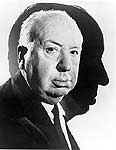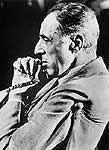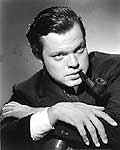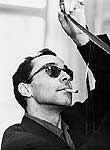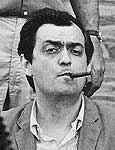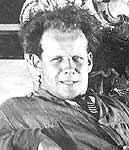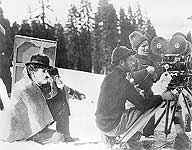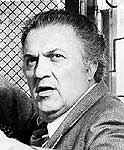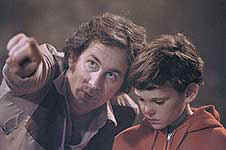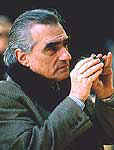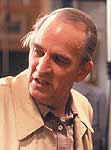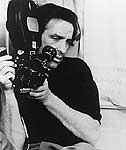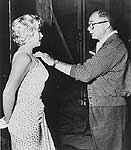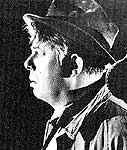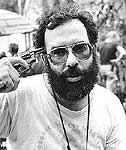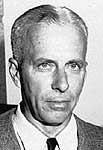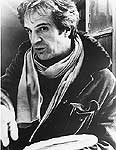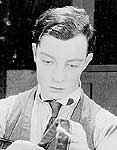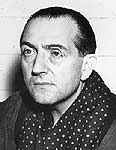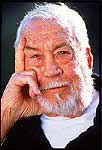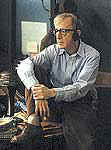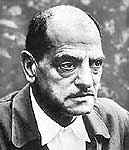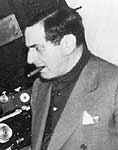|
MOVIE DIRECTORS TOP 25
|
||||||
|
HOME | BIOLOGY | FILMS | GEOGRAPHY | HISTORY | INDEX | INVESTORS | MUSIC | NEWS | SOLAR BOATS | SPORT |
||||||
|
In art, politics and history, each generation finds its own heroes. In the motion picture industry, is that really the case? The innovators who shaped the art form are the ones still asserting the most influence on moviemakers today. That is according to a poll of directors, writers, actors, critics and others who were asked : Who are the 25 most influential directors of all time?
Influence is defined as that intangible power which can affect a person, thing or course of events. Many believe that motion pictures, more than any other art form in the past century, have had a profound influence on modern life. I would say it was hard to argue against that. If one also accepts the generally held premise that directors, more than any other creative force in the film industry, are responsible for steering and shaping motion pictures, then perhaps film directors as a group have had a vastly underestimated effect on the way society thinks and behaves.
But who has had the most influence on other directors, as well as the public? In the past 100 years, which directors have made an indelible impact on our lives, and on the face of the movie industry? In what ways have these directors helped to define cinema as we know and see it today? With the help of some of our most celebrated moviemakers and industry professionals, we have counted down the directors who made the most difference—and continue to do so today.
Alfred Hitchcock
1. Alfred Hitchcock (1899 – 1980)
Alfred Hitchcock did not invent modern cinema, but for much of the past century he has defined it. Inarguably the most imitated motion picture artist of all time, a slew of spine-tingling hits including Rebecca, Rear Window, Vertigo and North by Northwest brought international acclaim to the London-born director, earning him the moniker “The Master of Suspense.”
While Hitchcock’s work certainly tended toward the thrilling, it was not as much his ability to keep audiences on the edge of their seats as it was to pull them out of their chairs that made him a legend—drawing moviegoers into his films and challenging the role of viewer as detached spectator. Widely hailed as his masterpiece, 1960’s Psycho took audiences into the recesses of a disturbed mind, making use of a fast-paced, adrenaline-inducing editing style and a succession of POV shots. With a perfectly measured combination of style and innovation and seamlessly blended bits of humor and romance throughout his work, Hitchcock’s films are a whole experience, usually playing upon a variety of human emotions. Though he was considered a legend in his own time, making more than 65 films in a career that spanned over half a century, the only Academy Award Hitchcock ever won for directing was an honorary one given in 1976, when he made history once again by uttering the briefest speech in Oscar history: “Thank you.”
D W Griffith
2. D.W. Griffith (1875 – 1948)
There are two sides to every film—the story, and the technique used to tell it. While success on both parts is the test of any director’s talent, it’s not always the case that even the most influential directors triumph on both counts. While the techniques employed by D.W. Griffith serve as the foundation of moviemaking, for many critics of cinema the stories he told are now best forgotten.
Considered the father of modern moviemaking, Griffith made over 450 short films while employed at American Biograph in the early 1900s. With this prolificacy came the opportunity to experiment with the mechanics of film. His collaborations with cinematographer Billy Bitzer yielded the discovery of such editorial innovations as crosscutting and flashbacks, elevating the medium of film to one of true storytelling capabilities.
With 1915’s The Birth of a Nation, Griffith made the film that would change his career. Though audiences poured into theaters to see it, the film’s overt racism and heroic depiction of the Ku Klux Klan were deemed inappropriate, and the film was banned in eight states. Though the controversy continues today (in 1999, the Directors Guild of America renamed the D.W.
Griffith Award, their highest honor, the Lifetime Achievement Award, citing that Griffith “helped foster intolerable racial stereotypes”), there is no denying his impact on the industry. Says critic David Sterritt: “He made many a bad movie, and his career petered out when his storytelling sense failed to keep pace with his formal ingenuity—and with new generations of spectators bored by the Victorian formulas he obstinately mistook for real experience. Still, his name remains solidly linked with techniques and devices taken for granted to this day, from the artful use of close-ups and flashbacks to the complexities of parallel editing and multiple narrative. His most ingenious movies, from the best Biograph shorts to features like Intolerance and the notorious Birth of a Nation, remain a source of ideas and inspiration for open-minded auteurs as different as Oliver Stone and Wong Kar-Wai, to mention just two who have clearly benefited from his brilliance.”
Orson Welles
3. Orson Welles (1915 – 1985)
What D.W. Griffith invented, Orson Welles perfected. With no previous film experience, Welles was given a contract with RKO Pictures (that included final cut) when his 1938 “War of the Worlds” broadcast sent radio listeners into a state of panic. The result: Citizen Kane, the most studied film in history of cinema.
Unlike the innovators before him, the techniques employed by Welles and his Kane team (including DP Gregg Toland and editor Robert Wise) seem contemporary even by today’s standards. The film’s unique cinematography, accomplished through the use of a “deep focus” lens created by Toland specifically for the film, reevaluated the impact a single image could have. Bringing every person, prop and nuance of a scene into focus, deep focus widened the canvas on which Welles could paint his picture, so that each viewing could offer up something new for the audience.
For the larger part of his post-Kane career Welles floundered. He pushed several ideas to various stages of development, but ran into walls each time when he couldn’t find the financial backing. Though a pariah in Hollywood, Welles has continued to influence each new crop of moviemakers, regardless of genre. Documentarians Albert and David Maysles were struck by Welles’ philosophy of film when they spent a week with him in Madrid in the early 1960s. Their nine-minute recording of that time shows Welles talking about an upcoming project (that would become The Other Side of the Wind). He tells the Maysles that “Some of the greatest moments in film have been divine accidents.” Recalls Albert today, almost 30 years after the taping, “As documentarians, that hit us right between the eyes. I’ve always remembered that.”
Regardless of the place he came to hold in an industry always looking for the next big thing, the interminable influence of Citizen Kane is no accident. Even if Welles’ legacy is defined by that first brilliant film, the influence of Kane is so vast that the director’s place in film history is guaranteed for the generations to come. Each viewing of Citizen Kane yields a new cinematic innovation and a deeper understanding of a genius at work.
Jean-Luc Godard
4. Jean-Luc Godard (1930 -)
He wasn’t the first of the French New Wave directors, but he was the most celebrated. His 1960 film Breathless heralded a new kind of moviemaking—one that was free from studio constraints and continues to permeate the very heart of independent film today.
Armed with an exhaustive knowledge of film history and a 16mm camera, Godard gave permission to later moviemakers to break the rules when it came to story, structure and process. Says Toronto Film Festival Director Piers Handling: “Godard challenged the accepted notions of how a film was constituted. His innovations included jump cuts, direct address to camera, the long take, disjunction of sound and image and an innovative use of the actor—all of which have become completely integrated in a variety of ways into contemporary film, music videos and commercials. His famous statement ‘A film should have a beginning, a middle and an end—but not necessarily in that order’ revealed his modus operandi. He had an enormous influence on the emerging national cinemas of the ’60s in Latin America, Africa and Eastern Europe, and no major filmmaker in America or Europe could ignore his radical challenge to established film grammar. Quentin Tarantino named his production company A Band Apart after Godard’s Bande à part, while Aki and Mika Kaurismäki’s unit was called Villealfa after Alphaville.
Jason Kliot, of Open City Pictures and Blow Up Films, puts it more succinctly: “Godard to modern film is what Picasso is to modern art—the ultimate daredevil and pioneer, the man who had no fear, the man willing to try anything in any genre and push it to its limits.”
John Ford
5. John Ford (1894 – 1973)
John Ford was a man of few words. Honest and straightforward in personality and technique, he was an all-American director who influenced a diverse slate of moviemakers from Martin Scorsese to Satyajit Ray. With film school not an option until much later in the 20th century, John Ford’s films became moviemaking class for budding directors the world over.
Ford was one of the most prolific directors in the history of cinema, and one of the few to be just as successful in the silent era as he was in the talkies. Though many consider his crowning achievement to be The Searchers, nearly his entire filmography attests to his genius. Primarily remembered for his westerns, Ford tried—and succeeded—at various genres. Stagecoach and The Man Who Shot Liberty Valance are considered great westerns, but his romance The Quiet Man, his adaptation of Steinbeck’s The Grapes of Wrath and his documentaries The Battle of Midway and December 7th were also widely revered.
Technically, Ford was the master of the long shot. His long, sweeping epics helped establish setting as a primary character. Says director Allison Anders: “For me the impact of seeing John Ford’s westerns was the use of space and American landscape. And presenting the land itself as powerful as it is on the screen, he was forced to also reveal several things: American mythology, the existential condition of the individual and, eventually and inevitably, the relationship of the Native American to the land we call America. That impact—his use of space and landscape and how that alone spoke volumes for the core of the American experience and myth—continues to be felt in every filmmaker who attempts to create a film about non-urban America.”
Stanley Kubrick
6. Stanley Kubrick (1928 – 1999)
Unlike other directors whose backgrounds are pulled apart to create a psychological profile meant to better understand their work, Stanley Kubrick never let on much about his past. His interest was based on aesthetics, making his contribution to the cinema relatively undiluted. And yet it was his confessional style that revealed vulnerability: he was using film to express emotion, and did so better than any contemporary director. Rather than have the audience watch an experience, Kubrick invited them to be part of it. Audiences felt the exhilaration of space travel gone awry with 2001, were horrified by the violence entrenching “their” city in A Clockwork Orange, experienced the psychosis of desolation in The Shining and tasted the appeal of adultery in Eyes Wide Shut. Kubrick’s films are not voyeuristic: they’re all-sensory adventures. But his films at not always love at first sight, either. Deeply layered in metaphorical meaning, they often require a certain digestion period—if not a second viewing—to fully realize their implications. Says editor Steve Hamilton: “[Kubrick is] the master of big (really big) budget art movies.”
Though he worked in many different genres, tackling horror, sci-fi, literary adaptations and war with just as much ingenuity, Kubrick never made a straight ‘genre’ film. Like the work of Hitchcock, Kubrick’s work displayed a full range of emotion. What could be horrifying one moment could become bitingly funny the next. His work was too complex to fit neatly into any one category, and he went about reinventing each new genre he touched, in essence making “A Kubrick Film” its very own label.
Sergei Eisenstein
7. Sergei Eisenstein (1898 – 1948)
With only seven completed films on his resume, Sergei Eisenstein’s influence may stem more from his theories—both written and demonstrated—on the possibilities of film than from his body of work itself. Released 10 years after The Birth of a Nation, Eisenstein’s landmark The Battleship Potemkin was directly inspired by Griffith’s advancement of the medium.
Potemkin’s 10-minute Odessa steps sequence is one of the most powerful testaments to the importance of editing and montage in film, and to the emotion such devices are capable of rendering. Brian De Palma “borrowed” the scene directly for 1987’s The Untouchables, when Elliot Ness and his men confront a group of Al Capone’s associates at a train station. Intended as a showcase for montage editing, Potemkin was just that. But when the rest of the world wanted to know more, Eisenstein was forced to reveal his secrets. Though his discoveries are often overlooked as a basic part of moviemaking, Eisenstein’s theories continue to affect the changing world of motion pictures.
Says critic J. Hoberman “As the best known of the Soviet montage theorists, Eisenstein has come to stand for the powerful (and basic) notion that cinematic meaning is a factor of editing—specifically the dynamic juxtaposition that is only possible with movies. In his writings, Eisenstein argued that it was possible to use montage scientifically to direct an audience to think and/or feel in a particular way. He not only anticipates propagandists of all political persuasions, but also Alfred Hitchcock (and his multitude of followers), as well as the makers of TV commercials and theatrical trailers.”
Though each of his films employed the same techniques as Potemkin, it only took that one film for Eisenstein to claim his place in cinema history. Alongside Griffith and Welles, Eisenstein is one of the major contributors to moviemaking technique, using innovation to heighten the audience’s visual and emotional relationship to film.
Charlie Chaplin
8. Charlie Chaplin (1889 – 1977)
In the transition from silent films to talking pictures, there were few survivors. Charlie Chaplin was an exception to the rule. As both actor and director, he was one of Hollywood’s first superstars, drawing record number audiences to the theater—and bridging the gap that existed between entertainment for children and adults.
But Chaplin also succeeded in making movies with meaning. As a physical comedian, he stands as one of history’s greatest, with the ability to express an extensive range of emotions without the benefit of words. At the same time, Chaplin aimed to say something with his movies, to talk about social and political injustices, but with a sugar coating to attract the largest audience. He’s still doing so, informing the work of everyone from Woody Allen to midnight movie king Lloyd Kaufman.
Says Kaufman, “I don’t know about other contemporary filmmakers, but Chaplin certainly influenced my movies. It is no coincidence that the Toxic Avenger’s ‘significant other,’ Sarah, is blind—City Lights is the obvious source. I could write a book about how Chaplin has influenced my movies, scripts, characters and themes.”
Not content to work around studio restrictions, Chaplin also pioneered the role of director as businessman. Continues Kaufman “Instead of being exploited by a studio as a contracted director like fellow geniuses Buster Keaton and Preston Sturges, Chaplin owned all his movies and benefited from the revenue derived from them.” Chaplin also saw the potential for a relationship between merchandising and film, emblazoning the image of The Little Tramp on clothing and toys—making a fortune and leading the way for future director-moguls like George Lucas.
9. Federico Fellini (1920 – 1993)
In a country marked by the documentary-like films of the neorealism directors, it could be considered ironic that Italy’s most famous director is one teeming with surrealism. But Federico Fellini is not so far removed from the work of Vittorio De Sica, Luchino Visconti and the neorealists before him: Fellini began his career as a writer, collaborating with Roberto Rossellini on the scripts for Paisan and Open City, two landmarks of the movement. But the inspiration for his own work came from life experience.
Fellini’s brief stint with a circus and early work as a caricaturist and cartoonist certainly informed his playful style. Though anchored in personal history, the impetus for his work was based more on his dreams—both waking and sleeping—than in any sort of day-to-day reality. As such, Fellini’s work is marked by a chimerical quality where everything and everyone is big and exaggerated. Yet, for the most part, his stories were quite accessible, helping him attain his status as a true visionary.
Unlike other directors who dared to be different by executing a new kind of simplicity, the work of Fellini magnified and enlarged all that had been attempted in cinema before. Though many have tried to imitate his style, his vision is too large to duplicate. The most one can hope for is to be deemed “Felliniesque.”
Steven Spielberg
10. Steven Spielberg (1946 - )
The “blockbuster” originated in 1976, when Steven Spielberg’s Jaws packed a record number of moviegoers into theaters around the country. Ever since, studios have been scrambling to one up each other for bragging rights at the box office.
More than 25 years after Jaws, Spielberg continues to deliver more big-budget successes than any other director, remaining prolific and popular at the same time. Probably the most bankable moviemaker working today, of the five highest grossing films of all time, two bear his directorial stamp. But success does have a price tag. For Spielberg, it’s the pressure of appealing to the largest possible audience, which occasionally means having to compromise. Though his Schindler’s List is no doubt one of cinema’s most powerful documents, films like the Indiana Jones series and Jurassic Park exemplify “entertainment” in its purest form.
Says MM’s Rustin Thompson: “It’s unfortunate that the blockbuster mentality that has gripped the movie industry since the summer of Jaws has superseded the influence of Spielberg’s talents. His craft has always been deft and elegant, but in recent years, buoyed by the knowledge that he can get away with just about anything, his films have been self-indulgent, lazy and sentimental. None of his post-’70s work bears up under scrutiny; none of it has the exuberant economy of Duel, The Sugarland Express, Jaws or Close Encounters of the Third Kind. It’s sad to realize that the very freedoms that allowed him to make those films have been bigfooted by today’s box office myopia. His influence cannot not be found in a director’s homage to classic Spielberg manipulations of light and off-screen space in Close Encounters, his precocious use of foreground in Duel, nor in the precise editing of the beach scenes in Jaws. Instead, one need only look at the ads for the latest dumb, must-see, comic-book extravaganza to realize the monster—much more voracious than a great white—that Spielberg quite unintentionally created.”
Martin Scorsese
11. Martin Scorsese (1942 - )
Part of the “new Hollywood” generation that emerged in the 1970s, Martin Scorsese is at the forefront of contemporary cinema, certainly one of the living masters, able to easily infuse a strong dose of reality into each installment of his work. His work measures the difference—both geographically and mentally—between Hollywood and New York.
Scorsese elevates the Freudian needs of sex and aggression to a heightened sensibility. He does not glorify violence, but he does beautify it. It would be hard to argue that the boxing scenes from Raging Bull aren’t some of the most exquisite caught on film. And the haunting conclusion to Taxi Driver is memorable not just for the actions that take place, but for the perfectly rendered image of insanity and disillusionment—a visual expression of a societal contention.
Though most often associated with his work in the gangster genre with films like Mean Streets and GoodFellas, it is not the intense action that makes Scorsese’s films so immensely watchable. Whether immediately recognizable or not, it is the spirit of his films as much as the visual stimulation that appeals to audiences. Says writer-director Jim McKay: “He’s one of the few veteran directors who has kept his passion and his artistic curiosity at the forefront. Decades into his craft, he’s still exploring, learning and taking chances. His work, unfortunately, affects today’s moviemakers much more in the stylistic realm (copycats pay “homage” to the grit, attitude and technical flair) than in the spiritual and artistic realm, which is where, I think, his brilliance lies.”
12. Akira Kurosawa (1910 – 1998)
One need look no further than John Sturges’ The Magnificent Seven (based on The Seven Samurai), Sergio Leone’s A Fistful of Dollars (a remake of Yojimbo) or George Lucas’s Star Wars (inspired by Hidden Fortress) to give credit where it’s due.
In a Time remembrance at Akira Kurosawa’s death, director Zhang Yimou said that “Other filmmakers have more money, more advanced techniques, more special effects. Yet no one has surpassed him.”
Says Facets’ Ray Privett,
“Kurosawa was one of the first ‘foreign’ filmmakers whose
work
Such is the mystery of Kurosawa: a man who made films in his native Japan, but was more greatly appreciated in the west. He made movies for the people of his country, but was criticized for alienating Japanese audiences. He was a director revered in America when relatively few of his 30 films ever made it to the continent. Yet he remains one of our greatest storytellers, mastering the art of effecting a cultural tale with worldwide significance.
Ingmar Bergman
13. Ingmar Bergman (1918 - )
With a team of regular collaborators, including actress Liv Ullmann and cinematographer Sven Nykvist, Ingmar Bergman brought the raw emotion of the stage to film, enchanting audiences around the globe. Working first as a playwright, Bergman’s unflinching interest in the pathos of his characters transcended language, affording him one of the most respected careers in cinema history.
Autobiographical in nature, his films display keen observations of the human condition, whether dealing in comedy or drama. Bergman’s scripts are intellectual and introspective, allowing a stellar group of actors to display more range in one performance than other actors have in their entire careers. Ignoring special effects, Bergman instead employed lighting as his tool of choice. Through constant collaboration, he and Nykvist innovated ways in which lighting could move the story forward: displaying emotion and revealing the hidden secrets of the characters. He easily transitioned the rules of theater to the medium of film, donating a uniquely uncomplicated—albeit not easily duplicated—style to the world of cinema.
As distributor Emily Russo says, “Bergman is quite simply an extraordinarily gifted artist; his originality blazed a trail and left an indelible mark on the cinematic landscape which continues to inspire and be emulated by countless filmmakers who follow him today. His concerns reached the depths of human emotion and spirit and proved to be universal in their language. No serious list of influential directors can fairly omit him.”
John Casavetes
14. John Cassavetes (1929 – 1989)
In his introduction to The Films of John Cassavetes: The Adventures of Insecurity, BU Film Professor and Cassavetes enthusiast Ray Carney asks: “Do any American feature films work harder to prevent viewers from reclining into their La-Z-Boys of the imagination? Cassavetes’ scenes deliberately swerve away from dependable courses and outcomes. Every time a scene is about to congeal into a predictable tone, Cassavetes will give it a stir; every time a relationship is about to stabilize, he’ll give it a push. Just when the audience thinks it’s figured out the relationship between two characters, a new piece of information or an emotional adjustment forces viewers to reevaluate everything.” Therein lies the inspiration in Cassavetes’ work, and the reason why his films never reached the wider consciousness of mainstream moviegoers: they require work.
Taking a cue from the French New Wave, Cassavetes could well be crowned the pioneer of the American independents. A successful Hollywood actor, he used the money he received from his television and film acting gigs to finance his first foray into film, 1960’s Shadows. Shot on 16mm without a script, the film touched upon many social taboos of the day, most notably that of interracial relationships.
Though seemingly chaotic, his films are meant to represent the true range of human emotions. His films require patience, just like real life. He favored actors as the rulers on set, letting their emotions get the best of them and taking the story where they wanted it to go. In doing so, he created some of the most realistic stories in contemporary cinema, and the most genuine characters—flaws and all—in the history of film.
Billy Wilder
15. Billy Wilder (1906 – 2002)
It could be considered ironic that Hollywood’s most beloved writer-director was actually born in Austria, never speaking the English language until he came to America in the 1930s. But perhaps it was his outsider perspective that made him such a keen observer of American behavior. With a slate of films, covering all genres, Wilder set his wit loose on America, and we have yet to recover. Few have managed to match his success in the business, nor his dedication to the occupation. Up until his recent passing, Wilder continued to go to his office each day and work on new ideas.
Says MM Editor at Large Phillip Williams: “In film after film—Lost Weekend, Stalag 17, Double Indemnity, Sunset Boulevard, The Apartment—Billy Wilder got audiences to fall in love with characters that, on a good day, might be considered loveable losers. The Wilder leading man—whether fallen drunk, cynical opportunist, kept writer or lovesick accountant—was always digging himself out of some self-generated pit. [His characters were] fully human and fully realized”. They were also wholly American.
Jean Renoir
16. Jean Renoir (1894 – 1979)
Never did the worlds of art and film collide as closely—or literally—than in the work of Jean Renoir. Employing the same masterful visual stimuli as his father, Auguste Renoir, did in his paintings, Jean Renoir discovered that simple adjustments to lighting, location, focus and camera angle could add new and exciting dimensions to a film. Selling some of his father’s paintings to finance his work, Renoir was a renegade moviemaker—too far ahead of his time to be fully appreciated.
Though
he’s best known for Grand Illusion, about a WWI
prisoner camp, Renoir’s most powerful work was probably The
Rules of the Game, a satirical take on a high-society
country weekend, originating the vein in which films like The
Celebration and
Says Slamdance Film Festival founder Peter Baxter: “Renoir is film’s great humanist. His perspective trapped the essence of the real world for the spectator—a human viewpoint that integrated actors, objects and space that expressed the relationship between individuals and society as one mutual tie-in.”
Francis Ford Coppola
17. Francis Ford Coppola (1939 - )
Though in recent years he seems to have settled comfortably into the role of director-for-hire, in the 1970s, Francis Ford Coppola was responsible for almost single-handedly resurrecting genres that had long been considered dead by Hollywood decision-makers. First with The Godfather and The Godfather Part II, he brought the gangster genre back to life, infusing it with humanity and paving the way for such later films as Martin Scorsese’s GoodFellas and Casino. Though war films had seen a bit of a resurgence with Michael Cimino’s The Deer Hunter and Hal Ashby’s Coming Home, Coppola’s Apocalypse Now was the one film that confronted the act of war and its effect on those involved. It was Apocalypse, more than any other film, the allowed directors like Oliver Stone to make Platoon and Born on the Fourth of July in the following decade.
Howard Hawks
18. Howard Hawks (1896 – 1977)
In a time when the studios called the shots, Howard Hawks proved that you could still be successful even if you didn’t play by the rules. As a novice director, he signed on with Fox Films to direct, but learned that the seemingly mandatory studio contract was one reason many directors and actors were being pigeonholed into certain genres, expiring early in Hollywood. Hawks refused to be put into such a position, and made sure his first contract was the only one he ever signed.
As a result, he proved to be one of the industry’s most versatile directors, genre-jumping throughout his career, almost always to great success. Though he is often associated with the screwball comedy—with films like Bringing Up Baby and His Girl Friday—Hawks was just as at home with film noir (The Big Sleep), westerns (Red River), gangster films (Scarface), war movies (Sergeant York) and literary adaptations (To Have and Have Not).
Francois Truffaut
19. François Truffaut (1932 – 1984)
Though generally considered less important than Godard in the French New Wave brigade, François Truffaut kicked off the movement when The 400 Blows premiered at Cannes in 1959. Originally entering the industry as a critic with the influential journal Cahiers du Cinema, Truffaut published the infamous (and industry-changing) article “A Certain Tendency in the French Cinema” during his tenure. The article caused a stir among film critics and theorists—claiming that true innovation in film would only be achieved if the director asserted him/herself as the driving force behind it.
Not one to hide behind his words, Truffaut set about proving his theory, creating the autobiographical The 400 Blows. Like many other directors cited here, the enormous—and immediate—triumph of his freshman effort proved a difficult feat to live up to in later years. Though he had enormous success with such later films as Jules and Jim, Day for Night, Farenheit 451 and The Last Metro, the style he had helped to pioneer had become commonplace by the time his later efforts arrived, reducing Truffaut to—like many cinema innovators—constantly having to defend his later works.
Buster Keaton
20. Buster Keaton (1895 – 1996)
It is difficult to make mention of Buster Keaton without also mentioning his biggest rival, Charlie Chaplin, as their intended demographic was essentially the same. But even in the 1920s, audiences were split between the two camps. Those who know both of the comedians’ work know that, though the on-screen image was similar, their methodology and intentions were completely different. Born into a family of vaudevillians, Keaton was first put on the stage as a child, becoming the third player in his parents’ act, which revolved around disciplining a misbehaved young boy.
In 1917, Keaton moved from stage to screen, starring in a slate of Fatty Arbuckle shorts, and bringing the physical comedy that had been instilled with him. But unlike Chaplin, Keaton was willing to take physical risks for his comedy, performing all of his own (often life-threatening) stunts, including jumping onto a moving train and setting up a house to fall on top of him, all in pursuit of a laugh.
Says actor Bruce Campbell: “Buster was the ballsiest of all the silent era guys, bar none. His genius was very simple: he used the magic of movies to showcase his outrageous physical abilities better that anyone else. It’s one thing to be a great physical comedian, but it's another thing to know how to capture that on film."
Fritz Lang
21. Fritz Lang (1890 – 1976)
Though he backed out as the director of The Cabinet of Dr. Caligari, his work on the script and subsequent directorial efforts bear the imprint of a pioneer in the world of German expressionism. Lang was able to make the leap from silent films to talkies unharmed, and further managed to shape the history of film in two countries—in Lang’s case, Germany and America.
Long before the term was coined, Lang was making some of the greatest film noirs ever to exist, including The Blue Gardenia (1953), Human Desire (1954) and While the City Sleeps (1956). Interest in Lang’s work further increased when his landmark sci-fi film, Metropolis, was re-released in the 1980s—this time pitted against a contemporary rock soundtrack. Even without the aid of dialogue, Lang preferred to tell stories on a grand scale—epic fantasies and horrific legends—and did so easily within the limitations of the technology. He was resourceful and ahead of his time.
John Huston
22. John Huston (1906 – 1987)
Says writer-director Mika Kaurismäki of the life of John Huston: “John Huston’s film career lasted at least 57 years, more than the half of the first century of cinema. He started acting at the end of the 1920s, writing scripts in the beginning of the ’30s, and made his directorial debut in 1941 with the excellent The Maltese Falcon, that renewed the whole genre of detective films. The Asphalt Jungle is one of the classics of film noir; it inspired many directors, including Kubrick, who five years later made The Killing and Jean-Pierre Melville, who said that it was the most important American film of all time.
Huston was able to change with time and some of his later films (Fat City, The Life and Times of the Judge Roy Bean, Wise Blood and Prizzi’s Honor) were absolutely modern films that achieved the critical acclaim normally associated with promising debut filmmakers. He was a painter, boxer, bullfighter, poet, hunter, soldier, gambler and filmmaker. He adored life and took risks. This can be seen in his films; no genre was impossible for him. The African Queen, Moulin Rouge, Moby Dick, The Misfits, Freud, The Night of the Iguana, The Bible, Casino Royale, Reflections in a Golden Eye, The Man Who Would be King are just a few examples of his range.
Huston was a storyteller whose films were always both well conceived and strongly character-driven, even to the extent that his ‘directorial style’ was often invisible. As James Agee says: “a wonderful breath of fresh air, light, vitality and freedom goes through every one of his images.”
Woody Allen
23. Woody Allen (1935 - )
Woody Allen is one of the few directors who has successfully turned imitation into an art form. With an encyclopedic knowledge of film history and theory, Allen has used the discoveries and innovations of some of cinema’s greatest masters to come up with a conglomerate style of his very own.
His films combine the physical comedy of Chaplin and cerebral wit of The Marx Brothers with the psychological exposition of Bergman and the haphazard camera technique of Godard. He is paradoxically comedic and intellectual—able to espouse his philosophical or political beliefs in an entertaining way or choreograph a pratfall just as easily. Though his films have rarely been moneymakers in the United States, Allen is one of America’s most recognizable directors, with an enormous following the world over.
Says screenwriter Alan Sereboff: “Quite simply, Allen is 50 years into his film career and still making the movies he wants to make, taking lessons from the finest that preceded him in developing a style distinctly his own. Some of the more influential directors on the list have become so at the price of alienating a portion of their audience—such is the price of genius. He has remained an auteur, true to himself and his audience. And, perhaps most importantly, he made it okay for a writer to be neurotic and successful.”
Luis Buñuel
24. Luis Buñuel (1900 – 1983)
Though he chose moviemaking as opposed to fine art, Luis Buñuel’s kinship with Salvador Dalí was evidenced in his work, as he elevated surrealism in film to a new level. In fact, it was this same friendship that would ultimately jumpstart Buñuel’s career. With assistance from Dalí, he made his first film, the short Un Chien Andalou. Praised for its surrealistic attributes, it was with the support of various art patrons that Buñuel would go on to make his feature debut with the scathing L’Age d’Or.
Unlike many other directors on this list, Buñuel’s career would make its deepest impression in its latter part, beginning with 1964’s Diary of Chambermaid, a film he made at the age of 64. It would be followed by his most renowned—and austere—surrealistic undertakings, including Belle de Jour, The Discreet Charm of the Bourgeoisie and That Obscure Object of Desire, films that combined the worlds of fantasy and reality, always leaving viewers to anticipate the unexpected.
Ernst Lubitsch
25. Ernst Lubitsch (1892 – 1947)
“Hitchockian” and “Felliniesque” are two common adjectives in the English language. But the one director who left an entire phrase as part of his legacy is Ernst Lubitsch.
Though some contend that “The Lubitsch Touch” was a phrase concocted as a publicity stunt—an attempt to ‘brand’ the director and increase his popularity—the term stuck. It has come to signify a certain bit of sophistication, wit and intelligence in film, making it possible for a director not to bend the rules of cinema, but find a way around them. Like Billy Wilder (whom he collaborated with on Bluebeard’s Eighth Wife and Ninotchka), Lubitsch’s razor-sharp observations of America were probably due in large part to his standing as an outsider, having only left his native Germany in 1922. Says writer-director Sherman Alexie: “I wish his love of spoken language was more common in contemporary movies. The people in his movies were so damn smart, so clever, so biting and satiric, yet were capable of being foolish and vain. I wish more movie directors used dialogue to convey character, rather than relying on image and action.”
Sticking mainly to comedies, Lubitsch relied on superb writing and strong actors to bring his stories to life, leaving camera experimentation and tricks to others. As a result, his “touch” is not seen in any heavy-handed visual style, but rather in the overall emotion of such films as Trouble in Paradise, The Shop Around the Corner, To Be or Not to Be and Heaven Can Wait. Whether the list provokes agreement or dissension, it is meant to encourage serious discussion about film. It is also meant as an educational tool. In the digital age, new movie fans and moviemakers are often looking to be led where technology takes them, resulting in an interest in film that is inclined toward newer works. Yet cinematic innovation was equally—if not more—present in cinema’s nascent years than it is today. While time has passed, many of these landmark works have been forgotten and pushed aside in the video stores for one of the 300 remaining copies of the latest summer blockbuster. As a result, legendary directors like John Ford, Sergei Eisenstein and Jean Renoir are bypassed. Perhaps a survey such as this will spark a renewed interest in the work of these and other pioneer artists.
Finally, reviewing film history’s influential people and moments helps to put in perspective the current state of moviemaking—both in America and abroad. The snapshot that emerged from our findings tells us three important things: first, that the lack of diversity in the 25 directors cited shows how far we need to go in incorporating more women and other minorities into the film industry. The second implication this list makes is that success—and influence—on the industry is a matter of quality over quantity. The fact that Sergei Eisenstein could crack the top 10—with only seven films to his credit—proves that the momentum from one film alone can extend generations into the future. And although Orson Welles, François Truffaut and Jean-Luc Godard have much larger filmographies, their inclusion is due, in large part, to the impact of a single early work.
Studios have always tried to lure all moviemakers into an established “system,” but it is those who have decided to break the rules. The true cinema mavericks have succeeded in being the most remembered and revered. Many claim that the current state of moviemaking is stagnant; it’s a statement that could be corroborated by the current slate of sequels and remakes that are littering the box office. But as the preceding list of directors proves, it’s in the times of homogenization that true creativity often asserts itself, leaving hope that the next great cinema renegade will heed the call. We can't wait.
A - Z FILMS INDEX
A - Z ACTORS INDEX
A taste for adventure capitalists
Solar Cola - a healthier alternative
|
||||||
|
This
website
is Copyright © 1999 & 2012 NJK. The bird |
||||||
|
AUTOMOTIVE | BLUEPLANET | ELECTRIC CARS | ELECTRIC CYCLES | SOLAR CARS |
